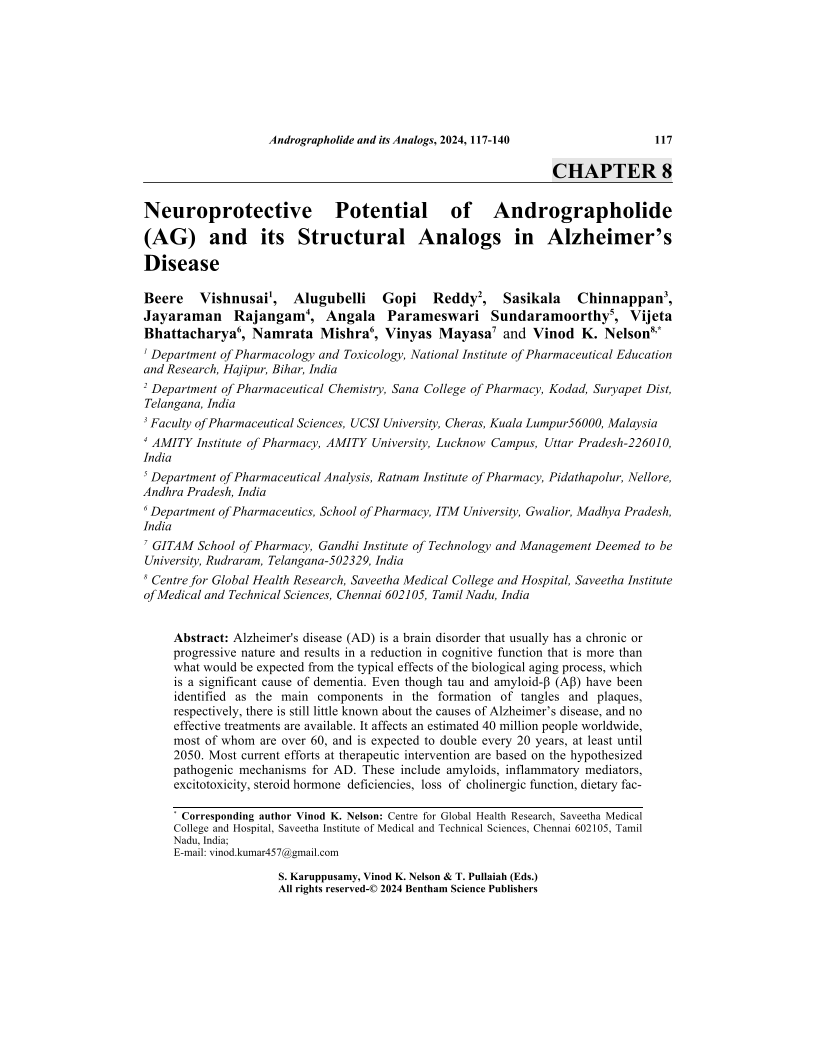Neuroprotective Potential of Andrographolide (AG) and its Structural Analogs in Alzheimer's Disease

- Authors: Beere Vishnusai1, Alugubelli Gopi Reddy2, Sasikala Chinnappan3, Jayaraman Rajangam4, Angala Parameswari Sundaramoorthy5, Vijeta Bhattacharya6, Namrata Mishra7, Vinyas Mayasa8, Vinod K. Nelson9
-
View Affiliations Hide Affiliations1 Department of Pharmacology and Toxicology, National Institute of Pharmaceutical Education and Research, Hajipur, Bihar, India 2 Department of Pharmaceutical Chemistry, Sana College of Pharmacy, Kodad, Suryapet Dist, Telangana, India 3 Faculty of Pharmaceutical Sciences, UCSI University, Cheras, Kuala Lumpur56000, Malaysia 4 AMITY Institute of Pharmacy, AMITY University, Lucknow Campus, Uttar Pradesh 226010, India 5 Department of Pharmaceutical Analysis, Ratnam Institute of Pharmacy, Pidathapolur, Nellore, Andhra Pradesh, India 6 Department of Pharmaceutics, School of Pharmacy, ITM University, Gwalior, Madhya Pradesh, India 7 Department of Pharmaceutics, School of Pharmacy, ITM University, Gwalior, Madhya Pradesh, India 8 GITAM School of Pharmacy, Gandhi Institute of Technology and Management Deemed to be University, Rudraram, Telangana-502329, India 9 Centre for Global Health Research, Saveetha Medical College and Hospital, Saveetha Institute of Medical and Technical Sciences, Chennai 602105, Tamil Nadu, India
- Source: Andrographolide and its Analogs: Botanical Sources, Phytochemistry, Pharmacology, and Biotechnology , pp 117-140
- Publication Date: December 2024
- Language: English
Neuroprotective Potential of Andrographolide (AG) and its Structural Analogs in Alzheimer's Disease, Page 1 of 1
< Previous page | Next page > /docserver/preview/fulltext/9789815256567/chapter-8-1.gif
Alzheimer's disease (AD) is a brain disorder that usually has a chronic or progressive nature and results in a reduction in cognitive function that is more than what would be expected from the typical effects of the biological aging process, which is a significant cause of dementia. Even though tau and amyloid-β (Aβ) have been identified as the main components in the formation of tangles and plaques, respectively, there is still little known about the causes of Alzheimer's disease, and no effective treatments are available. It affects an estimated 40 million people worldwide, most of whom are over 60, and is expected to double every 20 years, at least until 2050. Most current efforts at therapeutic intervention are based on the hypothesized pathogenic mechanisms for AD. These include amyloids, inflammatory mediators, excitotoxicity, steroid hormone deficiencies, loss of cholinergic function, dietary factors, oxidative stress, band g-secretase effectors, etc. Still, these therapies were neither completely effective nor safe for prolonged usage to check this problem. Various natural products have been tested. One such natural product is andrographolide (AG), which has several potential therapeutic benefits, including anti-inflammatory, immunomodulatory, and antiangiogenic properties. It is traditionally used for the treatment of various ailments. AG and its derivatives were found to be effective in the reduction of synaptic proteins associated with Alzheimer's disease by overturning the microglia-mediated growth of pro-inflammatory cytokines, and the research has shown that these compounds decrease amyloid beta aggregation and suppress the neuroinflammatory response and synaptic dysfunction. In the current review, the therapeutic potential of andrographolide and its analogs is outlined, and its mechanism of action against this disease is examined to explore the possibility of AG for the prevention and treatment of AD.
-
From This Site
/content/books/9789815256567.chapter-8dcterms_subject,pub_keyword-contentType:Journal -contentType:Figure -contentType:Table -contentType:SupplementaryData105

